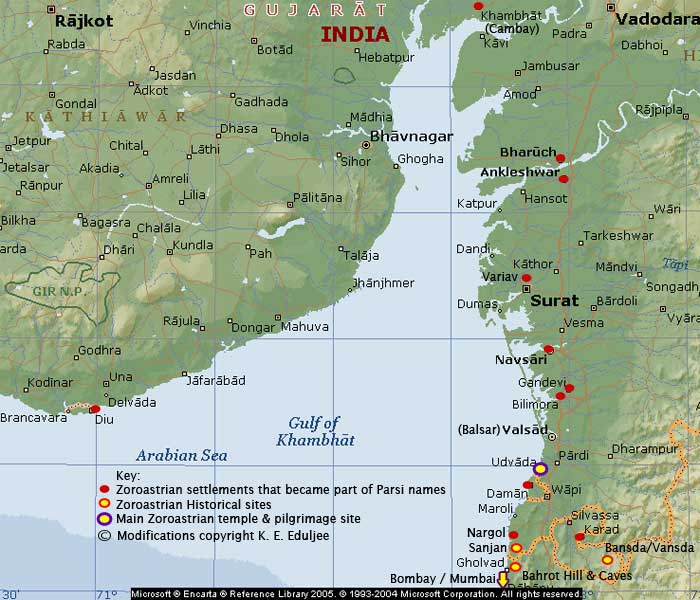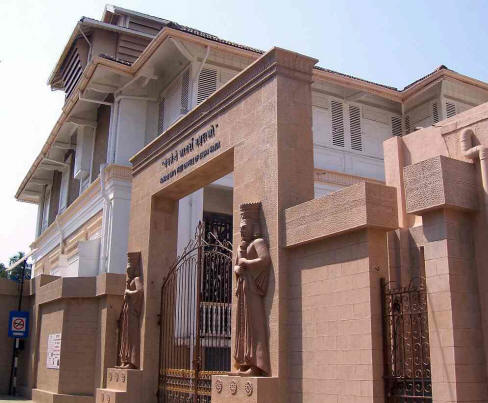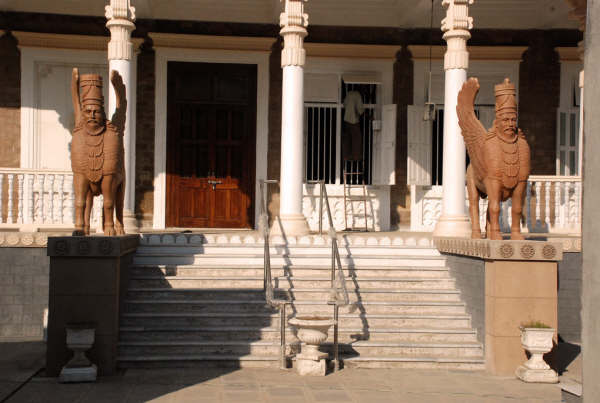
Contents
|
Pilgrimage pages:
Associated reading:
Description of the Udvada Atash Behram
The Udvada Atash Behram is a pilgrimage site for Zoroastrians from all over the world.
Nowadays in India, an Atash Behram (also spelt Bahram), meaning victorious fire, is the name given to both the highest grade of fire used in Zoroastrian worship as well as the temple that houses the fire. However, earlier in history, the building housing the fire in Navsari (a town north of Udvada) was called Atash-ni-Agiari. The Atash Behram building at Udvada was established 1742 ACE. This construction date makes the Udvada Atash Behram the oldest functioning Atash Behram in the world.
The Udvada Atash Behram fire, named the Iran Shah fire by the temple's priests, is reputed to have been consecrated in 721 CE (roz/day Adar, mah/month Adar, 90 AY). Anniversary celebrations commemorating the date the fire was consecrated called salgiri are held annually at the Atash Behram on the ninth day (named Adar) of the ninth month (also named Adar) of the Shenshai Zoroastrian calendar. Nowadays, the salgiri occurs at the end of April. In addition to the salgiri commemoration, special ceremonies are held on Bahram roj (the 20th day) of each month.
The fire presently in the Udvada Atash Behram was originally housed in an Atash Behram in the town of Sanjan where Parsi refugees from Iran landed by ship (dates range from 715 to 936 CE). While the Sanjan temple that housed the Atash Behram no longer exists, some pilgrims nevertheless include a visit to the historic town of Sanjan as part of their pilgrimage to Udvada. Some also include as part of their pilgrimage, visits to the Bahrot hills and caves, and the town of Bansda / Vansda. The residents of Sanjan hid in the Barhot caves after their defeat by Muslim forces (perhaps in the mid fifteenth century) taking the Atash Behram fire with them to the caves. When it was safe enough to leave the caves, they took the fire to the town of Bansda where it was housed for a short period.
The journey of the fire before it was brought to Udvada is recounted in the Qissa-e Sanjan and we provide a summary below in the section titled History of the Udvada Iran-Shah Atash Behram Fire.
 |
| Satellite image of Udvada village. Base map courtesy Google. Graphic modifications copyright K. E. Eduljee. Location source Wikimapia |
Location & Town
Udvada is a coastal village of the state of Gujarat, India. It lies 206 km north of Mumbai on the west coast of India. It can be accessed by car (a four hour drive, 198 km on highway NH8 plus another eight kilometres west on access road SH186) or by rail. Busy Udvada town staddles the highway and rail-lines while Udvada village, which contains the Iranshah Atash Behram fire and its temple, lie eight kilometres west of the city. Access road SH186 joins the town to the village.
For a travel guide see Indianetzone and Harmonyindia.
History of the Udvada Iran-Shah Atash Behram Fire
The history Udvada's fire mirrors the early history of Parsi-Zoroastrians in India. That history can be found on our pages on Early Parsi History - Qissa-e Sanjan. We will provide a brief overview here.
Storm at Sea. Pledge to Consecrate an Atash Behram Fire
One group of Zoroastrians who fled Iran after the Arab invasion in the mid 7th century CE, travelled by ship towards the coast of Gujarat. while at sea they encountered a fierce storm. They prayed for deliverance from the storm and pledged that if they should make safe landfall, they would consecrate an Atash Behram fire.
Fulfilment of the Pledge. First Atash Behram on Indian Soil
They were fortunate enough to survive their ordeal at sea and eventually made their home, with the consent of the local king Jadi Rana, at or near Sanjan. After they had settled down and established their roots, they petitioned the king for a lot of land three farsangs (nine kilometres) square that would be for the exclusive use of Zoroastrians. The king granted the Zoroastrians their request. The Zoroastrians using ritual implements brought over by immigrants from Khorasan in the old country, followed the lengthy process for consecrating the Atash Behram fire as well as constructing a temple to house the fire.
Sanjan's Atash Behram Becomes a Pilgrimage Destination
With the passage of time, the community grew and prospered. Zoroastrians began to settle in various parts of Gujarat, primarily the coastal, harbour towns, but also in places throughout India. For these Zoroastrians, the fire at Sanjan became a pilgrimage destination and this situation continued for seven hundred years after the original landing at Sanjan.
The dark clouds gathered on the northern horizon and Sanjan was invaded by Muslim forces of the Sultan Mahmud. After two fierce battles, the Sultan's forces prevailed and the Zoroastrians of Sanjan had to flee for their lives. Sanjan was destroyed.
 |
Gujarat (India) towns where Parsees settled
Image credit: Base map courtesy Microsoft Encarta. Additions copyright K. E. Eduljee |
Hiding in the Barhot Caves
Taking their sacred fire with them, the Zoroastrians of Sanjan fled to the 1,500 foot high Barhot hills some twenty two kilometres to the south. There they hid and lived in caves for twelve years.
Refuge in Bansda
When it was safe to emerge from their hiding place, the Zoroastrians took their flame with them and marched eighty kilometres east to the Zoroastrian settlement at Bansda / Vansda. The local Zoroastrians welcomed them warmly and the fire was suitably housed. Bansda now became the pilgrimage destinations for Zoroastrians wishing to pray before the Atash Behram. During this time, pilgrimages to the Atash Behram that had been suspended while the fire was kept in hiding at Barhot, resumed and according to Hodivala (p. 113) "Just as before men used to go... to far famed Sanjan, so now the Parsis came to Bansda... with numerous offerings." One such pilgrim was the renowned philanthropist Changashah / Changa Asa of Navsari.
Atash Behram Moved to Navsari
Changa Asa, the benefactor from Navsari, tired of making the difficult journey to Bansda during the rainy season, the appointed time for the most auspicious pilgrimage. He convened a meeting and persuaded the residents of Navsari to engage in negotiations to bring the Atash Behram to their town. The conditions must have been to the satisfaction of the Sanjana priests looking after the fire, for after a two-year (some say fourteen-year) stay at Bansda, the fire was moved to that town.
In 1516, Changa Asa had an Atash Behram built in Navsari to house the fire.
For a three year period from 1733-1736, the fire was temporarily housed in Surat to keep it safe from bands of lawless brigands roaming the countryside and then brought back to Navsari when the safety situation improved.
The Sanjana priests developed a working relation with the local Navsari priests, the Bhagarias on the sharing of duties maintaining the Atash Behram and related religious observances. However, a dispute arose between them that led to an unfortunate law suit brought before a Hindu court. The court's decree that the Sanjana priests must limit their activities to serving the fire only was unsatisfactory for the Sanjanas (the priesthood as well as the priestly duties are hereditary).
Chronology:
Sanjana-Udvada Atash Behram at Various Locations |
One possible reconstruction (out of many) of the years during which the
Sanjan-Udvada Atash Behram resided at various locations is as follows:
|
| Place | Stay | Start-End Year |
| Sanjan | 672 years | 721-1393 CE |
| Bahrot | 12 | 1393-1405 |
| Bansda | 14 | 1405-1418 |
| Navsari | 313 | 1419-1732 |
| Surat | 3 | 1733-1736 |
| Navsari | 5 | 1736-1741 |
| Valsad | 1 | 1741-1742 |
| Udvada | 265+ | Sunday, October 28, 1742 to date |
Fire Taken to Udvada in 1742
The Sanjana priests left Navsari with their fire in 1741, taking it to Bulsar/Valsar/Valsad some 32 kilometres from Navsari - a town under Sanjana jurisdiction. There, the fire was temporarily housed in one of Valsad's two agiaris. Unable to reach an accord with the local priests on how to divide the duties and income from pilgrims, the Atash Behram's priest decided to move the fire once more to the coastal fishing village of Udvada where a building was built as its new home.
A Surat leader Bhikhaji Eduljee (d. 1780), a resident of Surat, funded the building of the Atash Bahram and the process consecration of the temple commenced.
The Udvada temple was consecrated in 1742 CE and the Sanjana priests moved the now thousand year old Atash Bahram once more to the new temple on Sunday, October 28, 1742. There the fire has remained to this day.
The privilege of serving the fire remains with nine families who have descended from the three priests who rescued the fire from the destruction of Sanjan. The position of High Priest or Dastur, rotates from the head of one of the nine families to the other.
The Atash Behram's temple building at Udvada has undergone extensive renovations from 2007-2009.
 |
| Atash Behram in 1909. Image credit: William Thomas Fee, National Geographic |
 |
| Atash Behram pre 2007-09 renovations. Image credit: Various. Wikipedia |
|
 |
| Outer gate after renovations 2009 |
|
» Top
Pilgrimage pages:
Associated reading:
| 










